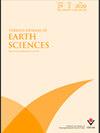Investigation of earthquake sequence and stress transfer in the Eastern Anatolia Fault Zone by Coulomb stress analysis
IF 1.1
4区 地球科学
Q3 GEOSCIENCES, MULTIDISCIPLINARY
引用次数: 1
Abstract
: A devastating earthquake with a magnitude of ( M w = 7.7) occurred on February 06, 2023, in the Pazarcık segment of the Eastern Anatolian Fault Zone, which has not shown major earthquake activity for a long time. On the same day, another earthquake with a magnitude of ( M w = 7.6) occurred in Ekinözü-Elbistan (Kahramanmaraş) in the northwest. Three more earthquakes with magnitudes of M w = 6.6, M w = 5.9, and M L = 5.7 occurred on the same day, and significant damage, loss of life, and property occurred in 11 provinces and districts. A sixth earthquake occurred with M w = 6.4 magnitude in Defne-Hatay on February 20, 2023. In addition, more than 32,000 aftershocks were recorded while this study was in progress. The interconnection of these earthquakes was investigated by Coulomb stress analysis. It showed compatibility with the distribution of both these six earthquakes and small aftershocks, in which earthquakes transfer stress to each other during their formation phases. By calculating Coulomb stress changes, mainshock ruptures have played an important role in transferring stresses between Elazığ and Malatya in the northeast, Kahramanmaraş-Göksun in the west, and Hatay and Syria in the south. Also, our calculations showed that shallow depths in and around source zones received positive stress changes (~1.0 bar) due to the focal depths of mainshocks with their aftershocks. Finally, it has been better understood with these earthquakes that the stress transfer time of high-energy earthquakes can be shortened considerably.通过库仑应力分析研究东安纳托利亚断裂带的地震序列和应力传递
:2023 年 2 月 6 日,东安纳托利亚断裂带的帕扎克(Pazarcık)地段发生了一次破坏性地震,震级为 7.7 级。同一天,西北部的埃基诺祖-埃尔比斯坦(卡赫拉曼马拉什)又发生了一次震级为 7.6 级的地震。同一天又发生了 3 次地震,震级分别为 M w = 6.6、M w = 5.9 和 M L = 5.7,11 个省区遭受严重破坏、人员伤亡和财产损失。2023 年 2 月 20 日,德夫内-哈泰发生第六次地震,震级为 M w = 6.4。此外,在本研究进行期间还记录了 32,000 多次余震。库仑应力分析研究了这些地震之间的相互联系。结果表明,这六次地震和小型余震的分布是一致的,即地震在形成阶段会相互传递应力。通过计算库仑应力变化,主震破裂在东北部的埃拉泽(Elazığ)和马拉蒂亚(Malatya)、西部的卡赫拉曼马拉什-戈克松(Kahramanmaraş-Göksun)以及南部的哈塔伊(Hatay)和叙利亚之间的应力传递中发挥了重要作用。此外,我们的计算还表明,由于主震及其余震的焦点深度,震源区及其周围的浅层受到了正应力变化(约 1.0 巴)。最后,我们通过这些地震更好地了解到,高能地震的应力传递时间可以大大缩短。
本文章由计算机程序翻译,如有差异,请以英文原文为准。
求助全文
约1分钟内获得全文
求助全文
来源期刊

Turkish Journal of Earth Sciences
地学-地球科学综合
CiteScore
2.40
自引率
10.00%
发文量
6
审稿时长
6 months
期刊介绍:
The Turkish Journal of Earth Sciences is published electronically 6 times a year by the Scientific and Technological Research
Council of Turkey (TÜBİTAK). It is an international English-language journal for the publication of significant original recent
research in a wide spectrum of topics in the earth sciences, such as geology, structural geology, tectonics, sedimentology,
geochemistry, geochronology, paleontology, igneous and metamorphic petrology, mineralogy, biostratigraphy, geophysics,
geomorphology, paleoecology and oceanography, and mineral deposits. Contribution is open to researchers of all nationalities.
 求助内容:
求助内容: 应助结果提醒方式:
应助结果提醒方式:


